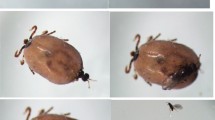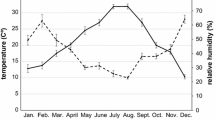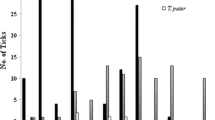Abstract
The parasitism of Ixodes loricatus Neumann on white-eared opposum, Didelphis albiventris Lund, was analysed in the southern ranges of both. In central Argentina, 118 wild opossums were captured from 2005 to 2012. Adults of I. loricatus were collected (prevalence = 66.1%, mean = 7.03, median = 4), but no immature stage. Tick infestation was not affected by sex (p = 0.27) or age (p = 0.37) of hosts. In line with previous studies about seasonality of larvae and nymphs of I. loricatus, adult tick infestation showed no seasonal trend. This lack of seasonal pattern of infestation for all parasitic stages of I. loricatus may indicate a life cycle governed by nidicolous behaviour, in such a way that this habit would contribute to minimize the influence of external environmental variables. The tick sex ratio was female biased, with two females per one male (p = 0.002). The absence of I. loricatus immatures on D. albiventris suggests that in the study region there is clear segregation of immatures in rodents and adults in marsupials.
Similar content being viewed by others
Avoid common mistakes on your manuscript.
Introduction
Ixodes loricatus Neumann (Acari: Ixodidae) is a three-host tick whose adults feed usually on didelphimorphs of the family Didelphidae, while nymphs and larvae have rodents of the family Cricetidae as their main hosts (Nava et al. 2017). There are also some unusual records from humans and cattle (Serra-Freire et al. 2011; Onofre-Barragán 2015), treated as doubtful in Guglielmone et al. (2014). Ixodes loricatus has been historically considered to range from Mexico to Argentina, but it is actually recognized as species from eastern South American species, established in Argentina, Brazil, Paraguay and Uruguay (Guglielmone et al. 2011), covering the Chaco, Pampa, Parana Forest, Brazilian Atlantic Forest, Cerrado and Pantanal Biogeographic Provinces (Guglielmone et al. 2011; Nava et al. 2017). Particularly in Argentina, I. loricatus is present in central-northern Argentina, with their southernmost ranges located in the Pampa Biogeographic Province.
The American order Didelphimorphia is formed by the family Didelphidae that contains the oldest terrestrial marsupials on Earth. Didelphis albiventris Lund is found from northeast and central Brazil and eastern Bolivia, Uruguay to central-northern Argentina (Cerqueira 1985). In the latter country, the distribution of D. albiventris as presented in Flores (2006) and Flores et al. (2006), roughly matches the distribution of I. loricatus, inhabiting a wide variety of environments from jungles, savannas, grasslands to rural and urban areas (Flores et al. 2006). Although this marsupial is considered the main host for the adults of I. loricatus (Guglielmone et al. 2011), there have been no quantitative studies describing this host-parasite association. On the contrary, the seasonality of larvae and nymphs of I. loricatus on Cricetidae have been evaluated in central Argentina by Colombo et al. (2014), who found no seasonal trend for this host-parasite relationship. Thus, the aim of this work was to quantitatively analyse parasitism by I. loricatus in populations of D. albiventris under the hypothesis than adult ticks, as the immature stages, present no seasonal trend.
Materials and methods
Data were obtained from samples of D. albiventris specimens trapped at two locaties in Santa Fe province, from 2005 to 2012. One locality was the Reserva Natural de la Escuela de Agricultura, Ganadería y Granja de la Universidad Nacional del Litoral (31°23′15″S 60°54′44″ W); the second sampling site was located at the Instituto Nacional de Tecnología Agropecuaria (31°11′46″S 61°30′9″W) near Rafaela city. Distances between sites is 73 km and both are located in central region to Espinal Eco-region sensu Burkart et al. (1999) called as ¨De los Algarrobos¨ in subhumid and the transition zone between Chaco to Pampa (Burkart et al. 1999) in central Argentina.
Didelphis albiventris specimens were captured on 26 occasions with four seasonal samplings per year in 2005, 2006, 2008, 2009 and 2012, and six during 2010, not recording data for the years 2007 and 2011. Forty Tomahawk life-traps were used, in a longitudinal study of four trapping grids with 10 traps each. Half of the traps were baited with chicken and the other half with banana, apple and honey.
The individuals captured were anesthetized at the capture site with Ketamine 15 mg/kg and Diazepam 0.5 mg/kg intramuscularly (Tarragona et al. 2014). The age of the hosts was determined by using the formula of the upper jaw, which considers the eruption and tooth wear (Schweigmann et al. 1995). Each individual underwent an exhaustive search for ticks, sexed, measured and weighed, and then released after recovering from the anesthesia.
Ticks were determined following Nava et al. (2017) and by comparison with known laboratory reared material deposited in the tick collection of Instituto Nacional de Tecnología Agropecuaria, Estación Experimental Agropecuaria Rafaela (INTA Rafaela), Argentina.
From the data obtained, the seasonal variation of the infestation with ticks in D. albiventris was described. We also compared the infestations, between males and females, young and adults of D. albiventris and males and females of I. loricatus. Statistical comparisons were made using the nonparametric tests of Mann–Whitney, Kruskal–Wallis and Spearman’s correlation test, and the parametric tests of prevalence (χ2 test).
The study protocol was approved by the Animal Ethical Commission of the Facultad de Ciencias Veterinarias de la Universidad Nacional del Litoral (protocol no. 28/08).
Results
Since no significant differences were determined between sampling sites, the results from both sites were grouped. A total of 118 individuals of D. albiventris, 61 males and 57 females were analysed. It was also determined that 35 of these individuals were young and 83 adults. Of the 118 individuals, 79 were parasitized with ticks. All ixodid ticks collected were adults of I. loricatus, except for 24 larvae of Ornithodoros genus.
Figure 1 shows the frequency distributions and prevalence of infestation with adults of I. loricatus per season. The frequency distribution figure shows the typical parasite aggregation, with most hosts carrying no or a few ticks. The mean for all hosts was 7.03, the median 4.0, and the prevalence was 0.661 (95% confidence interval: 57.56–74.64). Tick infestation reached to be highest during summer, but seasonal variation failed to reach statistical significance (p = 0.22, Kruskal–Wallis test).
Frequency distributions and prevalence of infestation per season, with adults of Ixodes loricatus on Didelphis albiventris. Although the prevalence of infestation with adults of I. loricatus in D. albiventris was more pronounced during the summer months, in the rest of the seasons the host parasite relationship was also observed
No significant effect of sex (p = 0.27, Mann–Whitney test) and age of D. albiventris (p = 0.38, Mann–Whitney test) on tick infestation were found. Conversely, female ticks were found more frequently than males of I. loricatus (p = 0.002, Mann–Whitney test), the mean M:F ratio was 1:2.
Discussion
Hoogstraal and Aeschlimann (1982), Gómez et al. (2000), Guglielmone et al. (2011), Saraiva et al. (2012), among others, reported immature stages of I. loricatus collected from marsupials, including Didelphis albiventris, but no larvae or nymphs have been collected on two populations repeatedly sampled in the present study. Our work lasted near than a decade, therefore the lack of infestation of D. albiventris with immature stages of I. loricatus appears to be a genuine characteristic of this host-parasite association in the southern range of its geographical distribution. There is consensus on the importance of cricetid rodent to sustain populations of I. loricatus pre-imagos (Guglielmone et al. 2011; Coelho et al. 2016: Colombo et al. 2014, 2015); therefore, it is hypothesized that cricetid rodents harvested almost all larvae and nymphs of I. loricatus at the study sites. While accurate assessment of encounter rates between hosts and ticks is extremely difficult, D. albiventris and A. azarae are overlapping extensively in both habitat and trophic niches (Cerqueira 1985; Musser and Carleton 2005). In other words, the composition of the marsupial and rodent fauna may result in different patterns of parasitism of those tick stages through their ranges.
The infestation reached with adults I. loricatus parasitizing D. albiventris was more pronounced during summer than in other seasons of the year but non-significant statistically, a result that agrees with the information presented by Colombo et al. (2014), who analysed the seasonality of I. loricatus immature stages parasitizing Akodon azarae, also in Central Argentina. Thus, it is estimated that this tick maintains a nidicolous behaviour, in such a way that this habit would contribute to minimize the influence of external environmental variables and, therefore no consistent seasonal pattern. A similar behaviour has been also found in other Neotropical tick as Amblyomma tigrinum by Nava et al. (2009); however, knowledge of non-parasitic life cycles of Neotropical ticks parasitizing wild vertebrates is meagre and additional efforts are needed to understand the biological cycle of I. loricatus, as well as for other species in the region.
The infestation levels by I. loricatus females parasitizing D. albiventris were higher than males. The aforementioned findings agree with Gómez et al. (2000). Mating in the genus Ixodes is considered to typically occur off the host, either before or after the female’s blood meal (Kiszewski et al. 2001). However, some species (Ixodes scapularis, Ixodes ricinus and Ixodes trianguliceps) as shown that mating may also occur on the host during female engorgement (Randolph 1980). Males of other nidicolous tick, Ixodes uriae, never feed in the adult stage and, therefore, have no association with the host during this part of the life cycle (McCoy and Tirard 2002). Although the life cycle of I. loricatus under laboratory condition has been studied by Schumaker et al. (2000), the reproduction cycle of I. loricatus under natural conditions are unknown and more studies are needed for comprehension the why of distribution pattern of females and males in their host.
No statistical association was determined for the case of infestation levels with I. loricatus between males and females and young and adults of D. albiventris. Lareschi (2010) found that I. loricatus immature prevalence parasitizing A. azarae was significantly different between sexes, being higher on males. Our study coincides with paper by Beldomenico et al. (2005), who described immature stages infestation similarity between males and females of rodent findings.
Didelphis albiventris is found in rural and urban areas; therefore, it is important to study the tick species that parasitize it. Although I. loricatus does not feed on domestic animals or man, it could be involved in the enzootic cycle of some microorganism. Studies conducted by Horta et al. (2006) in Brazil found that I. loricatus acts as a vector of Rickettsia bellii, a Rickettsia of unknown pathogenicity. Upcoming studies are necessary to determine the role that I. loricatus would play in the cycle of tick-borne diseases in Argentina.
References
Beldomenico PM, Lareschi M, Nava S, Mangold AJ, Guglielmone AA (2005) The parasitism of immature stages of Ixodes loricatus (Acari: Ixodidae) on wild rodents in Argentina. Exp App Acarol 36:139–148
Burkart R, Bárbaro O, Sánchez RO, Gómez DA (1999) Eco-Regiones de la Argentina. Administración de Parques Nacionales, Secretaría de Recursos Naturales y Desarrollo Sustentables, Buenos Aires, p 43
Cerqueira R (1985) The distribution of Didelphis in South America (Polyprotodontia, Didelphidae). J Biogeogr 12:135–145
Coelho MG, do Nascimento Ramos V, Limongi JE, de Lemos ERS, Guterres A, da Costa Neto SF, Rozental T, Rodrigues Bonvicino C, D’Andrea PS, Moraes-Filho J, Labruna MB, Szabó MPJ (2016) Serologic evidence of the exposure of small mammals to spotted-fever Rickettsia and Rickettsia bellii in Minas Gerais, Brazil. J Infect Dev Ctries 10:275–282
Colombo VC, Guglielmone AA, Monje LD, Nava S, Beldomenico PM (2014) Seasonality of immature stages of Ixodes loricatus (Acari: Ixodidae) in the Paraná Delta, Argentina. Ticks Tick Borne Dis 5:701–705
Colombo VC, Nava S, Antoniazzi LR, Monje LD, Racca AL, Guglielmone AA, Beldomenico PM (2015) Ecology of the interaction between Ixodes loricatus (Acari: Ixodidae) and Akodon azarae (Rodentia: Criceridae). Parasitol Res 114:3683–3691
Flores DA (2006) Orden Didelphimorphia Gill, 1872. In: Barquez RB, Díaz MM, Ojeda RA (eds) Mamíferos de Argentina. Sistemática y distribución, Sociedad Argentina para el estudio de los mamíferos
Flores DA, Díaz MM, Barquez RB (2006) Systematic and distribution of marsupials in Argentina: a review. In: Kelt DA, Lessa EP, Salazar- Bravo J, Patto JL (eds) The quintessential naturalis. Honoring the life and legacy of Oliver P. Pear, vol 134. University of California Publications. Zoology, California, pp 1–981
Gómez L, Santa Cruz AM, Borda JT, Lombardero OJ (2000) Nueva localización en Argentina de Ixodes loricatus Neumann, 1899 (Acari: Ixodidae) parasitando a Didelphis albiventris. Rev Med Vet Nordeste 81:340–341
Guglielmone AA, Nava S, Díaz MM (2011) Relationships of South American marsupials (Didelphimorphia, Microbiotheria and Paucituberculata) and hard tick (Acari:Ixodidae) with distribution of four species of Ixodes. Zootaxa 3086:1–30
Guglielmone AA, Robbins RG, Apanaskevich DA, Petney TN, Estrada-Peña A, Horak I (2014) The hard ticks of the world. Springer, Dordrecht, pp 978–994
Hoogstraal H, Aeschlimann A (1982) Ticks- host specificity. Bulletin de la Societé Entomolgique Suisse 55:5–32
Horta MC, Pinter A, Schumaker TS, Labruna MB (2006) Natural infection, transovarial transmission, and transstadial survival of Rickettsia belli in the tick Ixodes loricatus (Acari: Ixodidae) from Brazil. Ann NY Acad Sci 1078:285–290
Kiszewski AE, Matuschka ER, Spielman A (2001) Mating strategies and spermiogenesis in Ixodid ticks. Ann Rev Entomol 46:167–182
Lareschi M (2010) Ectoparasite occurrence associated with males andfemales of wild rodents Oligoryzomys flavescens (Waterhouse) and Akodon azarae (Fischer) (Rodentia: Cricetidae: Sigmodontinae) in the Punta Lara Wetlands, Argentina. Neotrop Entomol 39:818–822
McCoy KD, Tirard C (2002) Reproductive strategies of the seabird tick Ixodes uriae (Acari: Ixodidae). J Parasitol 88:813–816
Musser GG, Carleton MD (2005) Superfamily muroidea. In: Wilson DE, Reeder DA (eds) Mammal species of the world: a geographic and taxonomic reference. The John Hopkins University Press, Baltimore, pp 894–1531
Nava S, Mangold AJ, Guglielmone AA (2009) Seasonal distribution of larvae and nymphs of Amblyomma tigrinum Koch, 1844 (Acari: Ixodidae). Vet Parasitol 166:340–342
Nava S, Venzal JM, González-Acuña D, Martins TF, Guglielmone AA (2017) Ticks of the Southern Cone of America: diagnosis, distribution and hosts with taxonomy, ecology and sanitary importance. Elsevier Academic Press, London, p 352
Onofre-Barragán B (2015) Estudio preliminar de artrópodos de importancia veterinaria en El Carmen, Municipio de Xochistlahuaca, Guerrero, México. Boletín de la Sociedad Mexicana de Entomología (Nueva Serie) 1:118–121
Randolph SE (1980) Population regulation in ticks: the effects of delayed mating on fertility in Ixodes trianguliceps (Acarina: Ixodidae). J Parasitol 66:287–292
Saraiva DG, Fournier GF, Martins TF, Leal KPG, Vieira NF, Camara EMVC, Costa CG, Onofrio VC, Barros-Battesti DM, Guglielmone AA, Labruna MB (2012) Ticks (Acari: Ixodidae) associated with small terrestrial mammals in the state of Minas Gerais, southeastern Brazil. Exp Appl Acarol 58:159–166
Schumaker TTS, Labruna MB, Abel IDS, Clerici PTS (2000) Life cycle of Ixodes (Ixodes) loricatus (Acari: Ixodidae) under laboratory conditions. J Med Entomol 37:714–720
Schweigmann NJ, Pietrokovsky S, Bottazzi V, Conti O, Bujas MA, Wisnivesky-Colli C (1995) Estudio de la prevalencia de la infección por Trypanosoma cruzi en zarigüeyas (Didelphis albiventris) en Santiago del Estero, Argentina. Rev Panam Salud Publica 6:371–377
Serra-Freire NM, Sena LMM, Borsoi ABP (2011) Parasitismo humano por carrapatos na Mata Atlántica, Rio de Janeiro, Brasil. Entomol Brasilis 4:67–72
Tarragona EL, Zurvera D, Manzoli DE, Correa AI, Delgado AR, Magni C, Beldomenico PM (2014) Inmovilización química y evaluación fisiológica de comadreja overa, Didelphis albiventris (Lund, 1841) silvestres de la provincia de Santa Fe, Argentina. InVet 16:79–85
Acknowledgements
The authors thank Armando Rubén Delgado (Catedra de Bacteriología Universidad Nacional del Litoral-UNL), Darío Exequiel Manzoli, Ana Inés Correa, Leandro Raúl Antoniazzi, Maria Ayelen Teresita Eberhardt (ICIVET—Litoral, Universidad Nacional del Litoral-UNL) and “Grupo CAPIBARA” of the Facultad de Ciencias Veterinarias de la Universidad Nacional del Litoral, for help during field work.
Author information
Authors and Affiliations
Corresponding author
Rights and permissions
About this article
Cite this article
Tarragona, E.L., Mastropaolo, M., Zurvera, D. et al. Host-parasite association between Didelphis albiventris (Didelphimorphia: Didelphidae) and Ixodes loricatus (Acari: Ixodidae) in their southern ranges. Exp Appl Acarol 75, 129–134 (2018). https://doi.org/10.1007/s10493-018-0248-9
Received:
Accepted:
Published:
Issue Date:
DOI: https://doi.org/10.1007/s10493-018-0248-9





